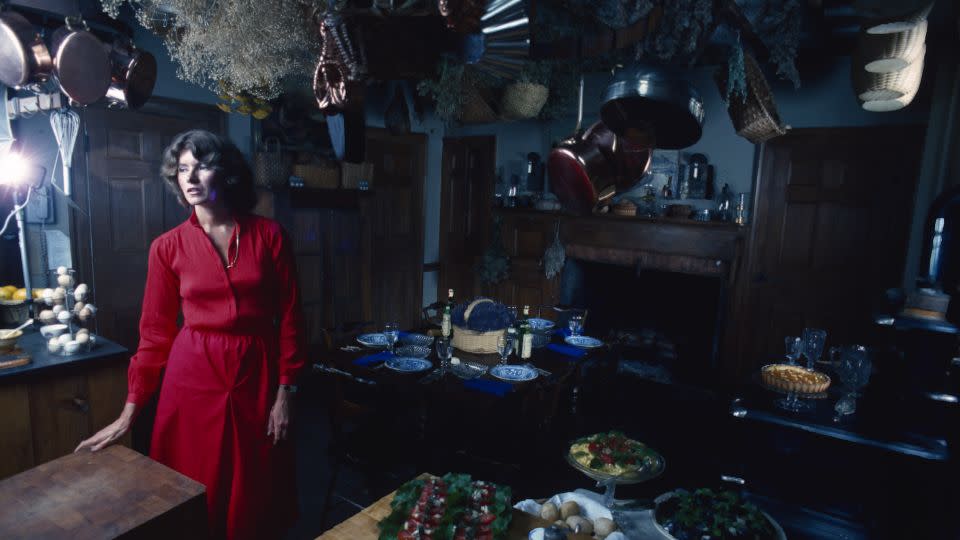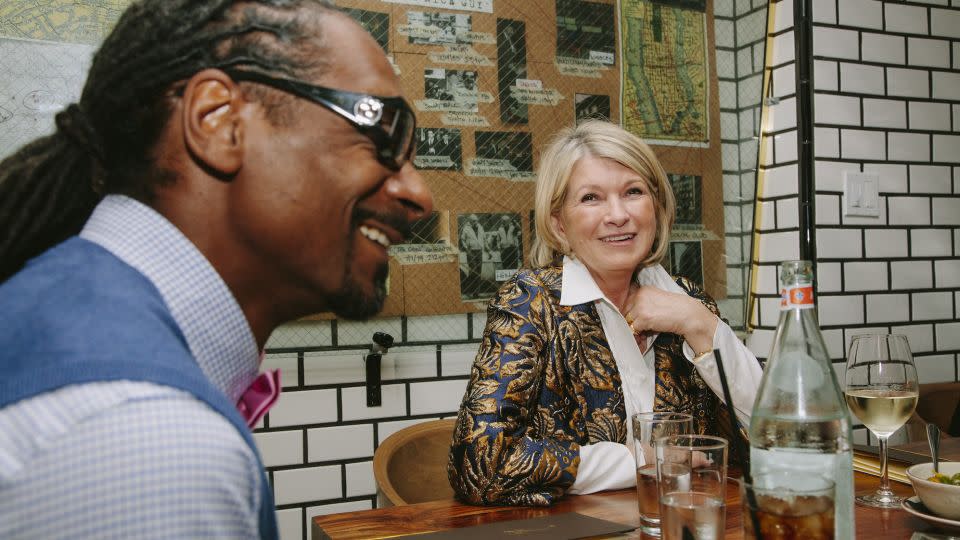Opinion: Everyone has an opinion about Martha Stewart
- Oops!Something went wrong.Please try again later.
Editor’s Note: Sarah Archer is a design and culture writer based in Philadelphia, PA. Her work has appeared in The New York Times, The Atlantic, Vox,The Washington Post and other publications, and her books include “The Midcentury Kitchen” and “Catland: The Soft Power of Cat Culture in Japan.” She writes a newsletter, “Cold War Correspondent.” The views expressed here are her own. Read more opinion on CNN. The new CNN Original Series “The Many Lives of Martha Stewart” premieres Sunday, January 28 at 9pm ET/PT.
It’s rare to meet someone who’s totally indifferent to Martha Stewart. She has her superfans, detractors, defenders, apologists and critics.

For some of us, she’s a figure best known for a moment of downfall: five months spent at a minimum-security prison in 2004 and 2005 after being convicted of conspiracy, obstruction and lying to federal investigators about a stock sale. For people in their 20s, she probably seems like an eccentric, highly entertaining serial entrepreneur.
In recent years she has opened a signature restaurant in Las Vegas, taken part in a merciless roast of Justin Bieber on Comedy Central, invested in CBD startups and promoted BIC lighters with Snoop Dogg – enjoying the perks of their unexpected and fruitful public friendship, and demonstrating that Martha has hit her stride with a laid-back public image that would have seemed unthinkable 30 years ago. She models Skechers on her Instagram feed, and in 2023 she graced the cover of Sports Illustrated in a bathing suit at the age of 81. This is not the Martha I remember, but I’m happy to know that the wickedly funny swimsuit model was in there all along.
The Martha of my youth was a kind of intellectual domestic goddess whose media persona and steely perfectionism were polarizing — and fascinating. She was a master of “homekeeping” who didn’t seem especially warm and fuzzy, a self-made billionaire whose expertise included techniques for polishing different kinds of metal, and a self-assured TV icon who was forthright rather than self-deprecating. She endured savage media coverage and never seemed to consider disappearing. Her insight that women would happily watch someone else do elaborate domestic projects on TV is arguably the ancient seedbed of today’s social media influencer landscape.
The trappings of her empire seemed personal and feminine — baskets, gardening tools, flour-dusted marble countertops — but her empire thrived in the business world. If critics resisted characterizing her as a feminist icon because her stock in trade was the domestic sphere, they would do well to note that Martha has always been modeling entrepreneurship in plain sight, and therein lies the rub.
For women who remember the “Martha Stewart Living” media empire at the zenith of its influence — the 1990s — she can inspire a feeling of inadequacy. Unlike her midcentury counterpart Julia Child, whose doughty charm and warm acceptance of mishaps endeared her to viewers nationwide, Martha was perfect. The spectacle of Martha dressing a Thanksgiving turkey, rewiring an antique lamp or making Dove Bars from scratch provides a kind of Rorschach test for women’s feelings about the domestic sphere and their place in it. And this isn’t because Martha herself is a perfect housekeeper per se; it’s because the arena of her professional ambition and success happened to take the form of domestic splendor.
I was in high school when “Martha Stewart Living” became a staple of weekend television, and on weekends my mom would wake me up to watch her TV show over breakfast. We were both intrigued by the confidence of its singular voice. Everything about it was educational: there were segments on collecting transferware ceramics or Fire King Jadeite, ideas for sophisticated Halloween decor, advice on how best to clean windows, tips for buying furniture at auction and insights from eccentric pet expert Marc Morrone.
Concepts like ease, shortcuts, speed or seeming effortlessness rarely surfaced. Ingenuity, quality and the value of good information were paramount. For women of Martha’s own generation — who were well into adulthood in 1974 when women won the right to apply for credit in their own names — Martha’s high standards could feel like an impossible mandate, a standard where falling short (even in the form of having no time or desire to do these things in the first place) meant a failure of taste, or worse, of womanhood.
For me, it was different. Reading Martha’s magazine or enjoying her TV show as a teenager was a little like reading Vogue or watching the Olympics: I marveled at what I was seeing, launched myself down research rabbit holes inspired by Martha’s taste in antiques and historic paints, occasionally imagined what it would be like to apply a complex gingham pattern to hardwood floors, and called it a day.

I loved Martha in part because I wasn’t thinking much back then about what it meant to be judged as a housekeeper, mom or hostess while also working full time. I didn’t imagine then, as I do now, what it may have been like for Martha herself as a working mother, trying to advance her career as a stockbroker, caterer and media mogul with the deck stacked against her.
Part of Martha’s message all along was the allure of bypassing readymade goods and making things from scratch. This ethos had deep roots in the natural food movement of the 1970s, and Martha’s own industrious childhood experience had prepared her perfectly to teach others how to make preserves or plant a vegetable garden. But she wasn’t exactly anti-corporate, either. She advocated tirelessly for a particular brand: her own.
As a cultural phenomenon, zeitgeisty thinker, and — yes — an influencer well before that concept existed for most people, Martha’s toolkit was built from the aesthetics, techniques, pleasures and challenges of the domestic world. She was never a housewife as we understand the term; from modeling to catering, Wall Street to Turkey Hill, she built a business using the expertise she’d developed as a child and young woman, in a creative realm that felt natural to her.
This paradox helps explain why people still have such strong opinions about her, and why there was so much fascination with Martha among the adults I knew — particularly the women — in the 1990s. Like the chatter that has followed Vogue editor Anna Wintour, there was always talk in publishing circles that Martha was demanding, exacting, difficult to work for. Rarely was there criticism of the magazine or the brand itself; it was always about her.

Martha’s perfectionism could almost seem like a taunt for a woman who balanced a 1990s professional life with 1950s-style domestic responsibilities. And in fact, the ritual of making something from scratch unites curious bedfellows: there are people like me, who view it as a joyful form of procrastination, and those who see it as the proper sort of task for women in a society obsessed with gender norms. The fact that such domestic tasks are time-consuming is part of the appeal: if women are kept in the home, they’re more likely to stay out of professional and civic life.
Even now, domestic work remains as grueling as ever. Martha’s vision lionized domestic creativity, but labor is labor, and for the domestic workers doing it, too many face low pay, workplace abuses or other forms of precarity. For straight married or cohabiting partners, women still do an outsized share of housework and caregiving.
Worse, the domestic realities for many women in America are backsliding; in the wake of the 2022 Dobbs decision, the hard-won victories of the 1970s look very vulnerable indeed. Even no-fault divorce, first legalized in California in 1969 and as central as credit cards to many women’s abilities to assert individual autonomy, is increasingly under attack. All of the things that make it possible for women to live full lives — personal autonomy in health care, finances and relationships, access to educational opportunities, career advancement and worker protections, access to childcare — remain scandalously out of reach for far too many American women.
It’s timely to consider Martha’s career and cultural impact now, at a moment when feminism’s brand has seen better days, and the fruits of its hard-won victories are more precarious than they’ve been in five decades. Perhaps it’s no accident that domesticity content is as hot as ever: Trad Wives pepper our Instagram feeds, cleaning their homes with baking soda by candlelight and mixing homespun tableaux with decidedly retrograde beliefs about families and gender.
In the 1990s, Martha may have appeared to be a mere caterer-turned media personality who happened to strike gold in TV and publishing. Because she communicated in the historically feminine language of domesticity, her acumen as a strategic businesswoman was underestimated by nearly everyone. But above all, she’s a self-made mogul who directly benefited from the advances of second wave feminism, professionally, creatively and financially.
Why does Martha remain fascinating to us? Perhaps it’s nostalgia. Not for antiques or baking with no shortcuts, but for the promise of an America in which a woman like Martha could monetize the mysteries of home economics at scale and put it to work in the service of her empire, rather than the other way around.
For more CNN news and newsletters create an account at CNN.com

